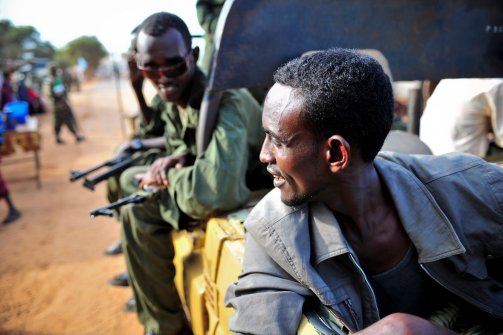Daily Beast
Monday, December 10, 2012

Members of the Somali National Army stand guard at Kismayo International Airport in November. (Tobin Jones, Reuters / AU-UN IST / Landov)
Retro white-metal-and-wood hospital beds—arranged in a cluster in the dappled shade of a broad tree—serve as the main emergency ward at Kismayo General Hospital. Emergency is the only kind of care the small team of hospital staff can provide with so few resources. For the past three years they’ve operated under the rule of Somalia’s al Qaeda–linked militants, Al-Shabab. “Explosion wounds and C-sections—that’s all we can cope with right now,” says the hospital director. His charges, 23 of whom arrived on the same day in October, when an IED exploded in town, suffer broken bones and injuries caused by shrapnel. Many also nurse gunshot wounds from stray bullets that government-aligned forces fired in the chaos after the attack.
Despite the apparent challenges, the hospital director presents the circumstances optimistically: By “using sparingly,” the hospital has managed to have enough emergency kits to treat the patients who come to the facility—the only hospital not under Al-Shabab control in the region. They do have anesthesia. The hospital recently signed an agreement with the World Health Organization to receive some surgical equipment and medicine—the first international support since Doctors Without Borders was forced to withdraw from the area in 2008 after three of its staff were killed in an IED attack. And two days after The Daily Beast interview, the hospital staff was slated to be paid for the first time by the city’s new post-Shabab administration.
The progress may sound nominal. But it’s emblematic of both the changes and the challenges afoot in newly liberated Kismayo—and an illustration of the level of isolation the people of this port city have endured.
With the territory they controlled shrinking—due in large part to operations carried out by the Western-backed African Union peacekeeping mission (AMISOM)—Al-Shabab consolidated its efforts around Kismayo, Somalia’s second-most strategic city after Mogadishu. Thanks in large part to Kismayo’s port, the militants generated an estimated $25 million in revenue in 2011 from taxes imposed on Somali charcoal shipments, primarily to the United Arab Emirates and Saudi Arabia, according to a report published by a U.N. monitoring group in July. Since the production of charcoal in the Kismayo area started around 1997, it has become by far the dominant industry, now accounting for 80 percent of business in the region, local investors estimate. “People in this community were doing the charcoal business since before the existence of Al-Shabab. So the issue isn’t Al-Shabab, the issue is that the businesspeople invested [almost solely] in charcoal because there was a lack of government. There was no control at all, no administration,” says Sheikh Hassan, speaking on behalf of a group of businessmen gathered for a meeting in a warehouse smelling of fish and petrol at the Kismayo port. “They were going for the cheapest business they could invest in so they can get their livelihood.”
What to do with the remaining stock of charcoal—which is barred from export by a U.N. embargo intended to stem Al-Shabab’s revenue stream and prevent deforestation of southern Somalia—is just one of the contentious issues that Kismayo’s new administration and Somalia’s new central government in Mogadishu need to jointly hash out. The charcoal owners say that the stock, much of which currently sits on a vast plot in town in mounds stacked two stories high, is worth $30 million to $40 million—though no one really knows the true value.
“For the moment, there’s no reason for there to be a fight” over charcoal, says a Nairobi-based international Somalia expert, noting that there will have to be a negotiated solution that draws in the charcoal owners and “their supporters with guns.” But he adds that Kismayo’s charcoal stock could spark political conflict. “If the [central] government remains adamant and tries to impose itself without a negotiated settlement, then in the context of the broader Jubba Valley issue, it’s just one more irritant to divide the two sides.”
Those divisions run deep, centering on the question of whether the southern region in which Kismayo sits will be able to establish itself as a semiautonomous state in the post-transition Somalia.
“The Constitution of Somalia spells out federalism as a key component of the administration of the country,” says Sheikh Ahmed Madobe, the commander of the most powerful militia in the region, who currently serves as the head of Kismayo’s governing body. “The central government must recognize that fact.” What that means in practice, according to Madobe’s interpretation, is that the three provinces of southern Somalia, bordering Kenya and Ethiopia, would combine to form the state of Jubbaland, with the power to govern with some level of autonomy from the central government in Mogadishu. There’s no doubt that Madobe, who has traded in his military attire for horn-rimmed spectacles, a collared shirt, and an embroidered Muslim prayer cap, is angling for the top post as governor.